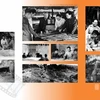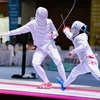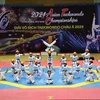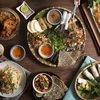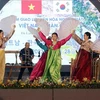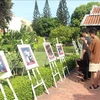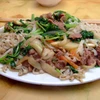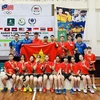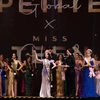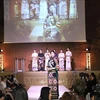 The exhibition is jointly organised by the Van Mieu-Quoc Tu Giam Centre of Culture and Science Activities and Nhan My School of Calligraphy. It features more than 100 works by 65 calligraphers in Nom script. This is the modern Vietnamese alphabet and Chinese characters created by local and international calligraphers. It is on display at the Temple of Literature on Vietnamese Teachers' Day 2022 (November 20), the day that teachers get all the attention and love they deserve. The theme of the event, “Mot moi xa thu,” indicates that Vietnam is a united country where political and cultural institutions are applied uniformly in all regions. (Photo: VietnamPlus)
The exhibition is jointly organised by the Van Mieu-Quoc Tu Giam Centre of Culture and Science Activities and Nhan My School of Calligraphy. It features more than 100 works by 65 calligraphers in Nom script. This is the modern Vietnamese alphabet and Chinese characters created by local and international calligraphers. It is on display at the Temple of Literature on Vietnamese Teachers' Day 2022 (November 20), the day that teachers get all the attention and love they deserve. The theme of the event, “Mot moi xa thu,” indicates that Vietnam is a united country where political and cultural institutions are applied uniformly in all regions. (Photo: VietnamPlus)  The works on display praise Vietnam’s tradition of respecting teachers and talented people and the tranquil beauty of historical monuments throughout the country, as well as Van Mieu-Quoc Tu Giam, the first university of Vietnam. Speaking at the opening ceremony, Deputy Director of the Hanoi municipal Department of Culture and Sports Tran Thi Van Anh said that the exhibition introduces to the public the ideological, cultural and aesthetic values of Vietnamese poems and literature, through the art of calligraphy. The event also aimed to gather those who share a passion for calligraphy, and called on their joint efforts to safeguard and uphold traditional cultural values, she stated. (Photo: VietnamPlus)
The works on display praise Vietnam’s tradition of respecting teachers and talented people and the tranquil beauty of historical monuments throughout the country, as well as Van Mieu-Quoc Tu Giam, the first university of Vietnam. Speaking at the opening ceremony, Deputy Director of the Hanoi municipal Department of Culture and Sports Tran Thi Van Anh said that the exhibition introduces to the public the ideological, cultural and aesthetic values of Vietnamese poems and literature, through the art of calligraphy. The event also aimed to gather those who share a passion for calligraphy, and called on their joint efforts to safeguard and uphold traditional cultural values, she stated. (Photo: VietnamPlus)  The exhibition is hoped to provide visitors with a deeper understanding of Vietnamese culture, which has been preserved and promoted throughout the journey from tradition to modernity. Visitors will see pieces that are written by steel brush, an example of how the art form has progressed and promoting calligraphy art in modern culture today. The exhibition introduces cultural and aesthetic values of Vietnamese literature works that are featured in calligraphy art. It helps visitors feel the traditional culture sources that have been handed down from generation to generation. It is a chance to honour traditional culture of the nation and Hanoi as well. (Photo: VietnamPlus)
The exhibition is hoped to provide visitors with a deeper understanding of Vietnamese culture, which has been preserved and promoted throughout the journey from tradition to modernity. Visitors will see pieces that are written by steel brush, an example of how the art form has progressed and promoting calligraphy art in modern culture today. The exhibition introduces cultural and aesthetic values of Vietnamese literature works that are featured in calligraphy art. It helps visitors feel the traditional culture sources that have been handed down from generation to generation. It is a chance to honour traditional culture of the nation and Hanoi as well. (Photo: VietnamPlus)  The event gathers those who share a passion for calligraphy, and calls for their joint efforts to safeguard and uphold traditional cultural values. Today, calligraphers and young people have worked together to preserve the ancient art form. In recent years, calligraphy has flourished. It is written on greeting cards, calendars, and decorations during the Lunar New Year Festival. Many calligraphy clubs have been set up, attracting young people. In the past, only old scholars could write calligraphy. Now, young people can do it. Calligraphy is like an art work, reflecting the writer’s soul. Each writer has his/ her own writing style, showing his/her life experience and knowledge of literature, language, and architecture. (Photo: VietnamPlus)
The event gathers those who share a passion for calligraphy, and calls for their joint efforts to safeguard and uphold traditional cultural values. Today, calligraphers and young people have worked together to preserve the ancient art form. In recent years, calligraphy has flourished. It is written on greeting cards, calendars, and decorations during the Lunar New Year Festival. Many calligraphy clubs have been set up, attracting young people. In the past, only old scholars could write calligraphy. Now, young people can do it. Calligraphy is like an art work, reflecting the writer’s soul. Each writer has his/ her own writing style, showing his/her life experience and knowledge of literature, language, and architecture. (Photo: VietnamPlus)  “Xa thu” means a united nation where political and cultural institutions are applied uniformly in all regions. The content of the calligraphy works praises the tradition of study and respect for teachers and morals of Vietnamese people who are associated with the Temple of Literature, the first university in Vietnam. They depict the beauty of Vietnamese landscapes and historical relics and show the ideology of "an bang, dinh quoc" or "maintaining the security of the Vietnamese people and the stability of the nation of Vietnam" of the famous Confucians and scholars of the feudal era. In addition, the calligraphers reproduced eight spring-themed poems by famous poets who lived from the Ly dynasty (1009-1225) to date. (Photo: VietnamPlus)
“Xa thu” means a united nation where political and cultural institutions are applied uniformly in all regions. The content of the calligraphy works praises the tradition of study and respect for teachers and morals of Vietnamese people who are associated with the Temple of Literature, the first university in Vietnam. They depict the beauty of Vietnamese landscapes and historical relics and show the ideology of "an bang, dinh quoc" or "maintaining the security of the Vietnamese people and the stability of the nation of Vietnam" of the famous Confucians and scholars of the feudal era. In addition, the calligraphers reproduced eight spring-themed poems by famous poets who lived from the Ly dynasty (1009-1225) to date. (Photo: VietnamPlus)  “Bach Dang giang phu”, a poem by famous poet and historian Truong Han Sieu is performed by calligrapher Vu Quang Huy. Through time, Vietnamese calligraphy has grown beyond its original meaning as the rule to write beautifully. It is an art of blowing the beauty into every single character. Vietnamese calligraphy also follows the standards of Chinese calligraphy and uses Han script (Chinese language) in many of its writings. However, as Han script failed to fully represent the richness of Vietnamese language, Nom script came to replace Han in Vietnamese calligraphy. Vietnamese script calligraphy is the most recent type of the art. (Photo: VietnamPlus)
“Bach Dang giang phu”, a poem by famous poet and historian Truong Han Sieu is performed by calligrapher Vu Quang Huy. Through time, Vietnamese calligraphy has grown beyond its original meaning as the rule to write beautifully. It is an art of blowing the beauty into every single character. Vietnamese calligraphy also follows the standards of Chinese calligraphy and uses Han script (Chinese language) in many of its writings. However, as Han script failed to fully represent the richness of Vietnamese language, Nom script came to replace Han in Vietnamese calligraphy. Vietnamese script calligraphy is the most recent type of the art. (Photo: VietnamPlus)  The calligraphers are inspired by the couplets at the Temple of Literature in the Temple of Literature-Quoc Tu Giam relic site and Vietnamese literary works. The Temple of Literature is a rare example of well-preserved traditional Vietnamese architecture dedicated to Confucius and honouring Vietnam’s finest scholars. Located in the south of the Imperial Citadel of Thang Long, this is often cited as one of Hanoi’s most picturesque tourist attractions. As Vietnam’s first national university, the Temple of Literature is a place of study rather than a religious landmark. It is ranked in Hanoi’s categories of Historic Sites, Points of Interest and Landmarks, Sacred and Religious Sites. (Photo: VietnamPlus)
The calligraphers are inspired by the couplets at the Temple of Literature in the Temple of Literature-Quoc Tu Giam relic site and Vietnamese literary works. The Temple of Literature is a rare example of well-preserved traditional Vietnamese architecture dedicated to Confucius and honouring Vietnam’s finest scholars. Located in the south of the Imperial Citadel of Thang Long, this is often cited as one of Hanoi’s most picturesque tourist attractions. As Vietnam’s first national university, the Temple of Literature is a place of study rather than a religious landmark. It is ranked in Hanoi’s categories of Historic Sites, Points of Interest and Landmarks, Sacred and Religious Sites. (Photo: VietnamPlus)  The exhibition draws a large number of domestic and foreign visitors. Only with the appearance of Vietnamese script did handwriting Latin letters in the country begin. Over the years, Vietnamese calligraphy has grown beyond its original meaning as a rule to write beautifully to become an art of making every single character beautiful. People pursuing the art of handwriting are of different ages. Sharing the love for the calligraphy, many of them see it as a way of relaxation. Although a young form of art, thanks to its high artistic and traditional values, Vietnamese calligraphy is now on the right path of development, attracting more and more practitioners. (Photo: VietnamPlus)
The exhibition draws a large number of domestic and foreign visitors. Only with the appearance of Vietnamese script did handwriting Latin letters in the country begin. Over the years, Vietnamese calligraphy has grown beyond its original meaning as a rule to write beautifully to become an art of making every single character beautiful. People pursuing the art of handwriting are of different ages. Sharing the love for the calligraphy, many of them see it as a way of relaxation. Although a young form of art, thanks to its high artistic and traditional values, Vietnamese calligraphy is now on the right path of development, attracting more and more practitioners. (Photo: VietnamPlus)  The art of calligraphy has always been considered an elegant hobby of people who are good at penmanship and are passionate about literature in Vietnam. Calligraphy is called “Thu Phap” in Vietnamese, “Thu” means script while “Phap” means rule, together the term means “the rule of writing”. Different from the Western calligraphy style, which uses a number of drawing tools like pen nibs, erasers, rulers, compasses, and squares to achieve accurate letter proportions, Vietnamese calligraphers only use brushes and black ink to achieve the beauty of philosophy hidden inside. Inheriting most of the quintessential qualities of Han - Nom calligraphy, Vietnamese script calligraphy was created and became prosperous during the last 10 years. (Photo: VietnamPlus)
The art of calligraphy has always been considered an elegant hobby of people who are good at penmanship and are passionate about literature in Vietnam. Calligraphy is called “Thu Phap” in Vietnamese, “Thu” means script while “Phap” means rule, together the term means “the rule of writing”. Different from the Western calligraphy style, which uses a number of drawing tools like pen nibs, erasers, rulers, compasses, and squares to achieve accurate letter proportions, Vietnamese calligraphers only use brushes and black ink to achieve the beauty of philosophy hidden inside. Inheriting most of the quintessential qualities of Han - Nom calligraphy, Vietnamese script calligraphy was created and became prosperous during the last 10 years. (Photo: VietnamPlus)  Different from the Western calligraphy style, which uses a number of drawing tools like pen nibs, erasers, rulers, compasses, and squares to achieve accurate letter proportions, Vietnamese calligraphers only use brushes and black ink to achieve the beauty of philosophy hidden inside. Vietnamese script calligraphy shares many similarities with Han - Nom calligraphy such as using brushes and Chinese ink, writing on white and red paper, having letters arranged inside round or square blocks, the position of the seal, and the meaning of the calligraphy. However, the follower is richer in terms of writing style. The exhibition will last until November 27. (Photo: VietnamPlus)
Different from the Western calligraphy style, which uses a number of drawing tools like pen nibs, erasers, rulers, compasses, and squares to achieve accurate letter proportions, Vietnamese calligraphers only use brushes and black ink to achieve the beauty of philosophy hidden inside. Vietnamese script calligraphy shares many similarities with Han - Nom calligraphy such as using brushes and Chinese ink, writing on white and red paper, having letters arranged inside round or square blocks, the position of the seal, and the meaning of the calligraphy. However, the follower is richer in terms of writing style. The exhibition will last until November 27. (Photo: VietnamPlus) VNA
